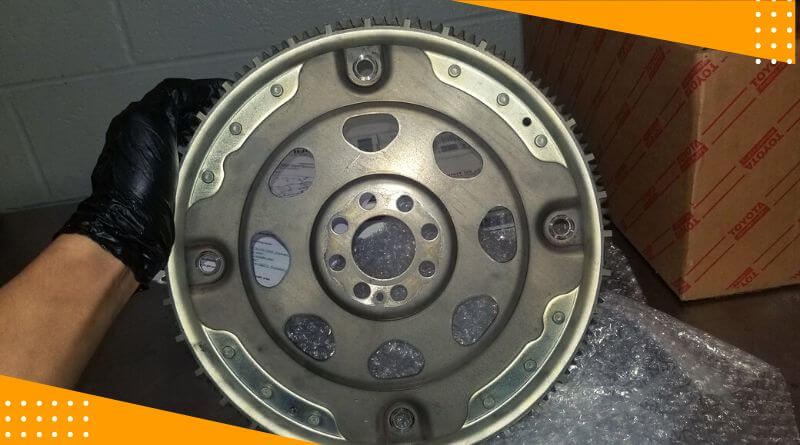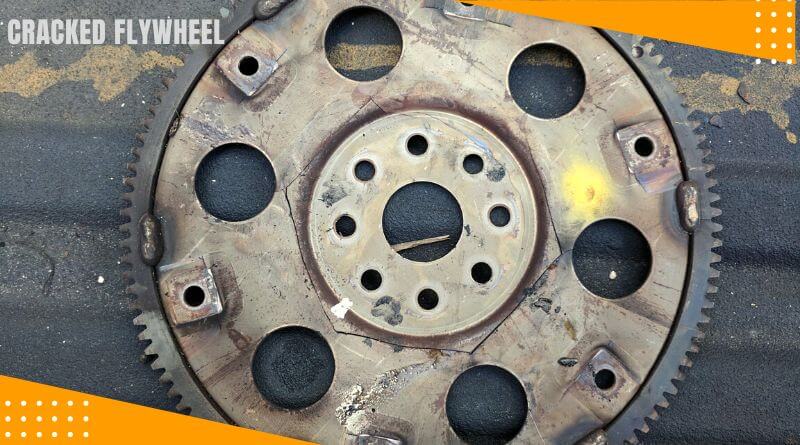Hey there! This post contains affiliate links to products. We may receive a commission for purchases made through these links. But it never influences our product selection process.
Do you hear any noise coming between the engine and transmission? If yes, then perhaps the problem is caused by the cracked flex plate rather than the engine. A cracked flexplate is one of the common issues that drivers may face while driving for a long distance. But my question is can I drive with A cracked flexplate?
In short, the answer is no. It isn’t possible to move with a cracked flexplate in the vehicle. Generally, a flexible plate attaches your engine to your gearbox. Even your car can’t move without it.
Well, that’s not all for today. Here I will try to reveal all the details related to the cracked flexplate, its reasons, symptoms and a lot more things. So, read till the end to find out more about it!
You may also like: Is it safe to drive with bad lifters
Can I Drive with A Cracked Flexplate? Let’s Dig The Depth

If you have a broken flexplate, the problem may be with how you installed it, or it may have been vandalized from overuse. Moreover, you must repair it as early as possible to avoid additional damage to the vehicle.
Using a faulty flex plate can cause a power loss to the vehicle wheels and lead to an accident. Moreover, many factors may cause damage to the flexplate. So, it’s better not to go out with a cracked or damaged flex plate.
Can I drive my car with a cracked flywheel? What’s The Problem?

When your vehicle’s flywheel is cracked, you may begin to feel a grinding noise from your pressure vessel, and eventually, your flywheel and other parts of the clutch may overheat.
Therefore, it may cause warping or even cracking. You cannot replace the parts if the flywheel and clutch are not substituted.
So, don’t drive with a cracked flywheel. If the scale is faulty, the vibrations will rattle the gearbox and engine, eventually leading to premature collapse. If your flywheel is sabotaged, it can fly out and cause irreparable damage to the transmission and engine. Thus, it’s important to check your flexplate every time you do any changes to your car. Such as straight piping your vehicle.
The clutch doesn’t work, which is probably causing the wrapping. It is most likely due to overheating. When replacing the clutch, it’s a good time to check and remake the flywheel or replace it if it isn’t.
If you find only one vibration or the vehicle has a mechanical transmission, the problem is most likely not warping. Auto machines use a little different setting for their respective steering wheel, and another factor may cause the problem.
A wrapped flywheel does not necessarily cause clutch vibration. If you rebuild an engine and notice that your flywheel is deformed, replace it as soon as possible. It’s ridiculous to set a broken part in a vehicle.
So, don’t try to drive with a cracked or warped flywheel. Instead, you can replace cracked ones with the ATP Automotive Z-270 Flywheel Flex-Plate or ATP Z-166 Flywheel Flex-Plate. Besides these, you can check out Mopar 0480 0696AA, Auto Trans Flexplate.
Read More: How to replace serpentine belt 6.7 Cummins
What causes a flexplate to crack? 6 Common facts

There are many reasons behind flexplate cracking but common 6 reasons behind flexplate cracking. So, here we go!
01. Guide pins missing:
Pivot pins prevent the plate from twisting and moving into place. The guide pins help attach the flex plate to your crankshaft hub, keeping it aligned as it rotates. If you find that the pivot pin is damaged, you should replace it immediately.
A broken pin can cause the crankshaft to move further, leading to bushing failure and possible engine damage.
Before replacing a flexplate’s broken pin guide, it is crucial to ensure that your crankshaft hub and pivot plate are correctly aligned.
If you don’t align the components after terminating the drive pin, it is vital to correct this alignment before going for a new drive pin.
02. Unbalanced engine, torque converter, and gearbox:
An unbalanced engine, torque converter, and gearbox can cause the hob to crack. The engine generates power transmitted to your car’s wheels through the gearbox.
A torque converter may transfer power from the machine to the gearbox. If one of these parts rotates at various speeds and goes over the line, it can result in uneven pressure on the flexplate. Therefore, it may break.
Besides, other heavily rotating transmission components, such as front-drive pumps, may lose their balance, which can rev the wear of the flex plate. Also, you might want to check your car if your break lights aren’t working.
03. Heavy Wear:
Your flex plate may be subject to heavy wear. That’s because it works continuously and transfers power from the machine to the gearbox. It may cause the hob to wear and break over time.
04. Bent crankshaft:
Flexplates sometimes indicate a bent crankshaft. It exerts uneven pressure on your flexplate as it rotates.
It can lead to plaque deformation and, ultimately, to its destruction. When you suspect your crankshaft bents, it’s essential to have it by an expert as early as possible.
05. Foreign bodies in the transmission:
You may damage the flexplate if foreign objects, such as metal or dirt chips get into the gearbox. Dirt can get between the starter teeth and hob, rubbing against them. Such polishing may damage or crack the flexplate.
Before installing a new one, it is crucial to clean the gearbox. You must remove all debris from the gearbox, and the fluid must be blushed and replaced.
06. Factory error:
The engine and gearbox are never aligned when assembling a vehicle. In fact, there is a minor misalignment like hair. This discrepancy continues to grow over time.
But things can get serious if the intrinsic misalignment during production exceeds the 0.2mm allowable tolerance. When it happens, the flexplate breaks and cracks.
What Are The Symptoms of a cracked flexplate: Know 7 Common Symptoms
Cracked flexplates are always risky to go with. So, you must know the flex plate failure symptoms before going with your car. 7 flex plate failure symptoms you should know about. So, here we go!
01. Cracked flexplate Noise:
The most obvious sign is the cracked flexplate noise when the engine runs. Sound descriptions include biting, honking, and tapping.
The cause of the noise is related to the position of the flexplate and its operation. These aspects ensure that the movement of the broken hob will cause noise while starting the engine and the drive.
02. Loss of power:
At a higher speed, the flexplate has a higher load and stress. If a crack occurs, it may not work as a betrothed, and one of the consequences is a power loss at a higher speed.
03. Poor fuel economy:
Like power loss, this symptom is common for a broken flexplate. Nevertheless, a broken flexplate reduces fuel economy due to its inefficiency in the motor when it doesn’t run properly.
04. Cracked flywheel symptoms:
The steering wheel of a car can keep rotational energy, capable of producing strong impulses when the vehicle is started.
Therefore, it is an essential car part, particularly in the manual gearbox. So, find out the symptoms of a cracked flywheel.
05. Gear slide:
Gear slip is the ineptitude of the vehicle to shift to the following gear, or your vehicle may change to the previous one, or the vehicle may accelerate slowly.
It may be due to a lousy flywheel that compels plate wear, increased contention, and oil pollution. Consequently, indoor flywheel machines are inclined to gear slide.
06. Smell of burning:
A common sign of bad steering is the smell of burnt toast. The smell of burning occurs due to excessive heating of the coupling surfaces. In fact, the excessive heat results from unnecessary clutch engagement.
07. Clutch vibration:
If you, as a driver, experience a louder hum or vibration when using the clutch, this is a lousy flywheel symptom. Usually, you can feel it from the car’s surface.
These increased surface noises are due to the failure of the steering wheel spring mounting mechanism. Moreover, it causes the steering wheel to be unable to reduce vibration when the driver engages the clutch.
You can watch this video to know more about Diagnosing a Broken Flex Plate:
FAQs: Drive with a cracked flexplate
What are the symptoms of a bad flexplate?
Metallic noise, creaking or rattling at the engine rear when the motor is idling. It is a common sign of a bad flexplate.
Broken flexplate noise when switching the engine forward or reverse is another symptom. Intense vibrations are felt through your driver’s seat at average speeds; abnormal engine operation and power loss at high speeds are also some apparent symptoms.
How long can you drive with a cracked flexplate?
No one can drive a car with a cracked flexplate for a few minutes. It may cause accidents, and you may endanger your life.
What happens when flexplate breaks?
When your flexplate breaks, it will often make a loud thud as it spins. The noise is similar to the lousy engine gauge.
Removing the torque converter bolts and screwing them back into your transmission may indicate the actual problem. In most cases, a broken flexplate may cause power loss and thus reduce fuel economy.
What does a flexplate repair cost?
You will need to dismantle the components, repair or replace the hinges, and reassemble the entire component.
The average flexplate component costs from $185 to $195 for just the plate. Labor, oil, and other costs can add around $1,500 or even more. So, it’s better to replace. In some regions, flex plate replacement costs about $50-$160.
Conclusion:
Flexplate is a crucial component of your vehicle. You may find a flexplate’s proper value if it breaks or cracks. In this article, I have discussed in a brief why flexplate breaks and what the symptoms are.
Don’t try to drive with your broken flexplate. It may harm you. So, taking care of and maintaining your flex plate is better. Happy driving!
- Is The Jeep Cherokee Frame or Unibody (Briefly Answered) - November 10, 2022
- Are Titan Wheel Spacers Good (The 360 Guidelines) - November 9, 2022
- FCW off Jeep (Is It Important for Your Car) - November 9, 2022

